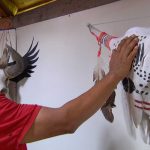St’at’imc survivors of the Kamloops Indian Residential School and their families will embark on a healing journey in March – a four-day walk called Náskan Ūxwal (I’m Going Home) that will take them from the school through St’at’imc territory.
The walk starts Sunday, Mar. 26 with a ceremony at the old school building, a brunch and a relay to the Bonaparte Indian Band near Cache Creek. On the second day, participants will walk from the Hat Creek/Marble Canyon Junction to Ts’kw’aylaxw and Xaxli’p. Day 3 on Mar. 28 will see participants walk from Xaxli’p to Sekw’el’was and then to T’it’q’et. The final leg of the journey will take them from T’it’q’et to Xwisten and then to Tsal’alh.
Ceremonies will be held in individual St’at’imc communities during the walk. There will also be events/gatherings leading up to the walk so that participants can prepare for the walk mentally, physically, spiritually and emotionally.
The Kamloops Indian Residential School (KIRS) was part of the Canadian residential school system and one of the 130 schools for First Nations children that operated in Canada between 1874 and 1996. The Kamloops School was opened in 1893 (initially as the Kamloops Industrial School) and continued operation until 1977. Thousands of children attended the school over the years, and were often forcibly removed from their homes once attendance became mandatory by law.
Children were not allowed to speak their native language or practise their own spirituality at KIRS, which was run by the Roman Catholic Church.
The KIRS was one of several residential schools attending by St’át’imc people; others included St. Joseph’s Mission in Williams Lake, Sechelt Indian Residential School, and St. Mary’s Residential School in Mission. Next month’s walk focuses on those who attended the KIRS.
“Locally, here in Lillooet, there were a lot of people who were just devastated by these schools,” Xaxli’p Chief Darrell Bob told the News. “The history is written on the walls of that building. The impact – the mental, physical, emotional and sexual abuse – has been devastating on our communities. I’ve always said, ‘We survived the impact of residential schools. Now it’s time to move beyond surviving to thriving within ourselves and taking our spirit back.’”
Chief Bob, who is the media contact for the walk, was a student at the Kamloops Indian Residential School, which he attended from 1965-66 to 1975.
He will be participating in the walk, which he describes as a “healing journey.”
He says he hopes non-Indigenous people will be supportive of the walk and the reasons for it.
“The human family has to understand the devastating impact that has been put upon our people by the government,” commented Chief Bob. “It was genocide; it’s hard to hear the word ‘genocide’ but it’s the truth. ‘To kill the Indian within the child,’ is the statement that was made. Today, the language is dying and that was the whole intention: ‘Kill the language, kill the child.’ The support from the human family involves understanding the history of what went on. There are horrifying stories that were not told, but understanding the history of residential schools is taught in schools today and it’s really critical to understanding the history of our people, and what they went through. The history that was taught in the past was very generalized. Yes, there were residential schools, but what happened behind closed doors was a different story.”
He said his own memories of residential school include the nuns poking children in the head with pencils and youngsters being hit in the ears with yardsticks if they didn’t speak English.
He also remembers that his own grandparents were told they would be jailed if they did not give over their children to the custody of the residential school.
For the purpose of his own healing, he has returned several times to the former KIRS, bringing his family with him so that he could explain what happened to him while he was there – “why Dad was the way he was, and that was key to my family’s healing.”
Chief Bob said he anticipates that joining other residential school survivors from his own and other St’at’imc communities will provide a sense of comfort and a sense that “We’re not alone. We all have our story, but there’s a support system that’s created by the people among themselves, the grass roots, and that is also healing.”
He added, “We all have our own stories, but we also made friends there and I’m looking forward to seeing them on the walk.”
Members of the Naskan Uxwal organizing committee are:
• Ina Williams (Xwisten)
• Garry Dunn (Xwisten)
• Chief Ida Mary Peter (Tsal’alh)
• Laurie Patrick (Tsal’alh)
• Linda McDonald (Xaxli’p)
• Barb Marchand (Xaxli’p)
• Marie Barney (T’it’q’et)
• Nicole Napoleon (T’it’q’et)
• Susan Napoleon (T’it’q’et)
• Charmaine John (Ts’kw’aylaxw)
• Rick Alec (Ts’kw’aylaxw)
• Vanessa Thevarge (Sekw’el’was)
Support for the committee is provided by:
• Sue Cheechoo – St’át’imc Outreach Health Services (SOHS)
• Steve Basil – Cultural Liaison (SOHS)
For more information, please see the Náskan Ūxwal FaceBook page
© Copyright 2017 Bridge River Lillooet News








